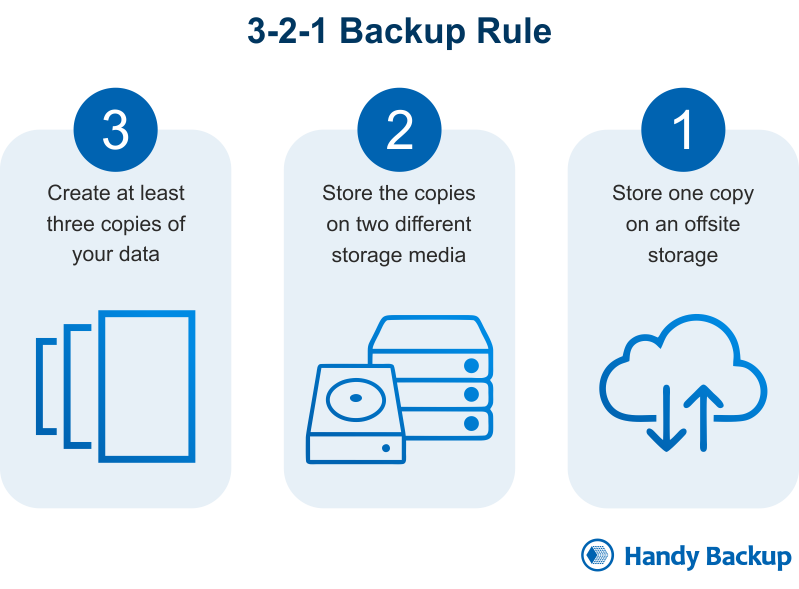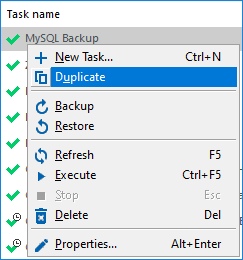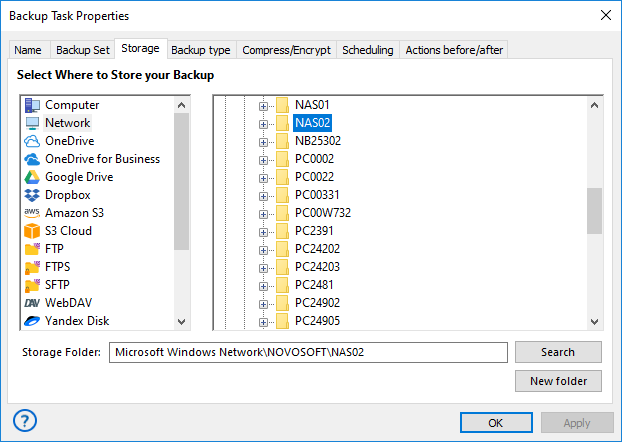3-2-1 Backup Strategy - The Golden Backup Rule
3-2-1 backup strategy involves creating three copies of your data, storing them on two different types of media, with one copy kept offsite for added security. Handy Backup is the perfect 3-2-1 backup solution for implementing this efficient technique, recognized as one of the most efficient strategies.
Download the free trial version of Handy Backup and experience the 3-2-1 backup solution in action.
What is 3-2-1 backup rule (strategy)?
The 3-2-1 backup strategy is widely recognized as one of the most effective methods for creating data backups.

The principles of the 3-2-1 backup rule are straightforward and universally applicable:
- Keep at least 3 copies of your data: one primary (original) data and two backup copies;
- Store the copies on at least 2 different types of storage media (e.g., another PC, external HDD, flash drive, NAS, or cloud);
- Store at least 1 backup copy off-site (e.g., in a cloud storage).
Strictly adhering to these simple guidelines as part of a "3-2-1 backup plan" can be a lifesaver for system administrators and experienced PC users in various scenarios.
Explanation of Terms
To provide a deeper understanding of the 3-2-1 backup strategy, let's delve into the terminology associated with this approach.
The Three Copies
Creating three or more copies of data on different storage devices mitigates risks inherent to specific devices. For example, hardware failure may affect a hard disk but not a cloud account; network mishaps might interrupt online data transfer but won't impact copying from a local disk, and so forth.
The Two Different Types of Storage Media
If one copy is stored as hard disk data, ensure at least one other copy is on FTP, tape, or a cloud service. This safeguards data from storage-specific risks.
The One Offsite Copy
The final principle of the 3-2-1 backup rule emphasizes keeping one or more backups off-site, i.e., not in the same room/building as the original. This ensures that if the original and local copies are physically destroyed (due to theft, fire, war, earthquake, or any other force), at least one data copy will be preserved.
Note: Nowadays, the optimal choice for offsite storage is often a commercial cloud. Options like Amazon S3, popular services like Dropbox or Google Drive, or even utilizing an FTP server are viable solutions for implementing the 3-2-1 backup strategy.
Version 8.6.6 , built on September 9, 2025. 153 MB
30-day full-featured trial period
By adopting this server backup strategy, you can ensure the security of your data. To implement the 3-2-1 rule for backup right away, all you need to do is download Handy Backup.
Technical Requirements for 3-2-1 Rule
The implementation of the 3-2-1 backup rule requires the availability of suitable storage devices, accounts, or vaults. However, there are specific requirements for these storage devices:
- Stable network connections are essential for online storage.
- Each storage type must have sufficient free space to accommodate regular backups.
- Both the physical and logical availability of each storage device are crucial during scheduled backup operations.
The significance of the last requirement can be clarified using the example of employing a USB drive for the 3-2-1 backup strategy. Clearly, this drive must be connected to a PC during scheduled backups. If this connection could interfere with other tasks, a viable alternative is to use a local drive instead.
Use Cases for 3-2-1 Data Backup Strategy
The 3-2-1 rule is versatile and applicable to a wide range of use cases, making it a preferred choice compared to more complex methods like Grandfather-Father-Son or Tower of Hanoi backup strategy. It can be effectively employed for various types of data backup, including:
- Back up photos, pictures, images, movies, audio files, and other multimedia content;
- Saving projects and work files, either for safekeeping or for sharing/co-working;
- Securing database copies, back up websites, CMS content, and saving online shops, etc.;
- Creating backups of crucial databases or arrays of virtual machines*.
- Ensuring comprehensive data center backup, protecting critical business data, applications, and system configurations from loss and ensuring business continuity.
- Aligning with HIPAA compliant backup requirements to ensure the security of sensitive medical data.
While the 3-2-1 backup strategy is well-suited for various backup scenarios, it may not be the optimal choice for creating disk images. However, this is not a strict rule, and this backup method can still be used for system recovery if needed. It's a versatile approach that offers redundancy without strict limitations!
* Databases and virtual machines are supported in Handy Backup Small Business and Handy Backup Server Network.
Is the 3-2-1 Rule Still Sufficient for Modern Data Protection?
Today, the simple 3-2-1 scheme (three copies of data, two different types of media, and one copy stored off-site) is increasingly being supplemented by more advanced options. Among them are the 3-2-1-1-0 and 4-3-2 strategies, which have emerged as a response to modern threats, including cyberattacks and ransomware.
The 3-2-1-1-0 Backup Method
The 3-2-1-1-0 model adds two important elements to the familiar scheme: one copy stored in isolation (for example, on a device disconnected from the network) and a “zero errors” requirement, meaning that backup data must be verified for integrity. This helps avoid situations where a backup exists but is damaged or infected.
The 4-3-2 Backup Strategy
The 4-3-2 strategy goes even further: it requires four copies, three different types of storage, and at least two copies stored outside the main office or home. This approach is especially important for companies and professionals working with large volumes of mission-critical information.
Both strategies help protect not only against hardware and software failures but also reduce risks related to human error and targeted attacks. In the end, the more layers of protection you use, the higher the chances that your data will remain safe even in the most unpredictable situations.
Advantages of These Approaches:
- Protection against viruses and ransomware attacks
- Reduced risk of data loss in case of failure or disaster
- Assurance of data relevance and integrity
- Ability to quickly recover even after a complete system loss
Disadvantages of Modern Data Backup Methods:
- More copies mean higher costs for hardware and cloud storage
- More complex administration (especially for home users)
Nevertheless, these backup rules are used today not only by large enterprises but also by small businesses and, in some cases, advanced home users. The more critical the data, the more important it is to add extra layers of protection. The 3-2-1-1-0 and 4-3-2 strategies ensure that even in the most serious failure, your data remains accessible and intact.
How to Implement the 3-2-1 Backup Method for Handy Backup Solution
Creating a new backup task is a straightforward process. Begin by following the instructions outlined in the User Manual. In this task, configure it to copy the original dataset from Step 2 to a locally selected storage location on Step 3. Once the first task is completed, make a copy of it in the main window.

Now, open the "Properties..." option from the context menu of the duplicated task. Rename it, and then choose a separate location to store data compared to the first task. You can also adjust the schedule for this second task to optimize data load.

Finally, create a third copy of a task (from the first or second task, it doesn't matter). Rename it again, choose a different location (offsite, such as a cloud) as is typical for implementing the 3-2-1 data backup rule, and re-schedule it. These three identical tasks will automatically implement the 3-2-1 rule of backup.
Version 8.6.6 , built on September 9, 2025. 153 MB
30-day full-featured trial period
Try Handy Backup to create a 3-2-1 backup rule by downloading now a free fully functional trial version for 30 days!
- Why is the 3-2-1 backup rule important?
There is an opinion that the 3-2-1 backup rule is excessive. Indeed, setting up backups in two separate locations can be a challenging task, and it may also be costly, since large volumes of data often require purchasing commercial cloud storage. However, experience shows that the issue is not only about protecting yourself from floods or fires, but also about the fact that physical devices from the same production batch can fail at the same time. If you create only one backup copy, you need to spend much more time verifying the integrity of your backups and regularly checking that each backup task has been completed successfully. With the 3-2-1 backuр strategy, you gain peace of mind, knowing your data is protected against both common failures and worst-case scenarios.
